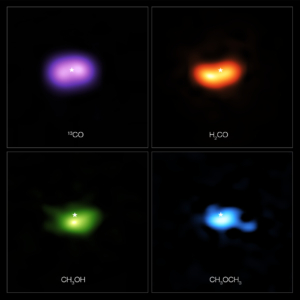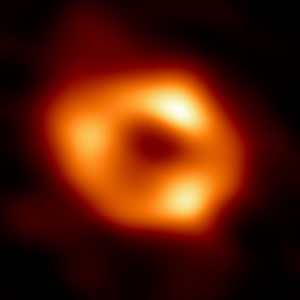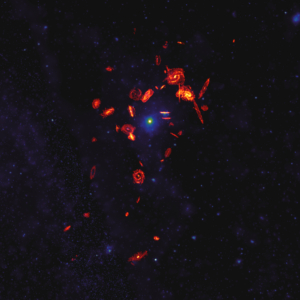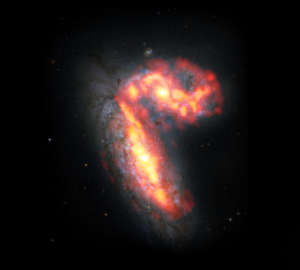These images from the Atacama Large Millimeter/submillimeter Array (ALMA) show where various gas molecules were found in the disc around the IRS 48 star, also known as Oph-IRS 48. The disc contains a cashew-nut-shaped region in its southern part, which traps millimetre-sized dust grains that can come together and grow into kilometre-sized objects like comets, asteroids and potentially even planets. Recent observations spotted several complex organic molecules in this region, including formaldehyde (H2CO; orange), methanol (CH3OH; green) and dimethyl ether (CH3OCH3; blue), the last being the largest molecule found in a planet-forming disc to date. The emission signaling the presence of these molecules is clearly stronger in the disc’s dust trap, while carbon monoxide gas (CO; purple) is present in the entire gas disc. The location of the central star is marked with a star in all four images. The dust trap is about the same size as the area taken up by the methanol emission, shown on the bottom left.


Monster at the Heart of the Milky Way Galaxy, Sgr A*
This is the first image of Sagittarius A* (or Sgr A* for short), the supermassive black hole at the centre of our galaxy. It’s the first direct visual evidence of the presence of this black hole. It was captured by the Event Horizon Telescope (EHT), an array which linked together eight existing radio observatories across the planet to form a single “Earth-sized” virtual telescope. The telescope is named after the “event horizon”, the boundary of the black hole beyond which no light can escape.
Although we cannot see the event horizon itself, because it cannot emit light, glowing gas orbiting around the black hole reveals a telltale signature: a dark central region (called a “shadow”) surrounded by a bright ring-like structure. The new view captures light bent by the powerful gravity of the black hole, which is four million times more massive than our Sun. The image of the Sgr A* black hole is an average of the different images the EHT Collaboration has extracted from its 2017 observations.

Dust Continuum and Molecular Transition Lines for SPT0311-58
These science images show the molecular lines and dust continuum seen in ALMA observations of the pair of early massive galaxies known as SPT0311-58. On left: A composite image combining the dust continuum with molecular lines for H20 and CO. On right: The dust continuum seen in red (top), molecular line for H20 shown in blue (2nd from top), molecular line transitions for carbon monoxide, CO(6-5) shown in purple (middle), CO(7-6) shown in magenta (second from bottom), and CO(10-9) shown in pinks and deep blue (bottom).

Animated Composite View of SPT0311-58
This animated gif moves through the dust continuum and molecular lines for water and carbon monoxide seen in ALMA observations of the pair of early massive galaxies known as SPT0311-58. This gif begins with a composite combining the dust continuum with molecular lines for H20 and CO. It is followed by the dust continuum seen in red, molecular lines for H20 seen in blue, molecular lines for carbon monoxide, CO(10-9) shown in pinks and deep blue, CO(7-6) shown in magenta, and CO(6-5) shown in purple.

VERTICO’s View of the Virgo Cluster
The VERTICO—Virgo Environment Traced in Carbon Monoxide—Survey observed the gas reservoirs in 51 galaxies in the nearby Virgo Cluster and found that the extreme environment in the cluster was killing galaxies by robbing them of their star-forming fuel. In this composite image, ALMA’s radio wavelength observations of the VERTICO galaxies’ molecular gas disks are magnified by a factor of 20. They are overlaid on the X-ray image of the hot plasma within the Virgo Cluster.

Virgo’s NGC 4567 and NGC 4568
NGC 4567 and NGC 4568 are two of the thousands of galaxies in the Virgo Cluster, located roughly 65 million light-years from Earth. Observed by the VERTICO—Virgo Environment Traced in Carbon Monoxide—Survey, the two galaxies are among those in the galaxy cluster impacted by extreme physical processes that can lead to the death of galaxies. The galaxies are shown here in composite radio data from ALMA with molecular gas in red/orange and optical data from Hubble Space Telescope with stars in white/blue.

